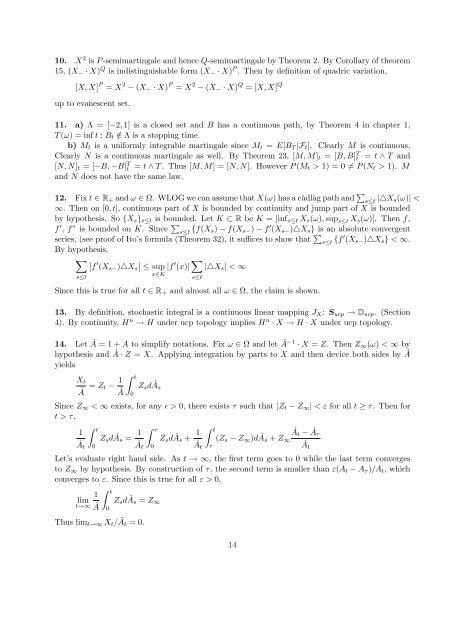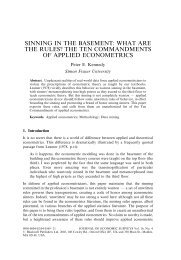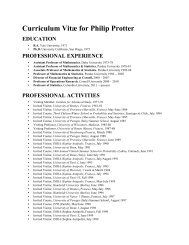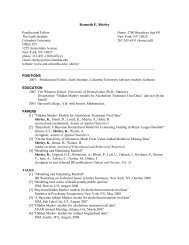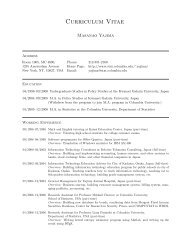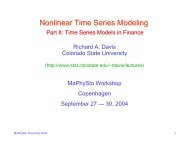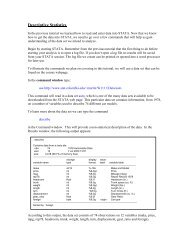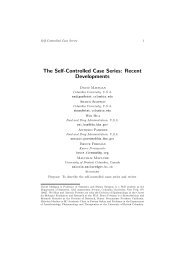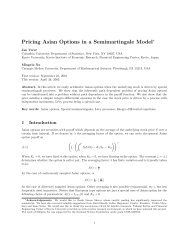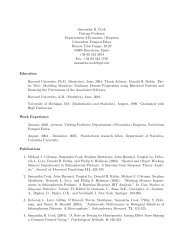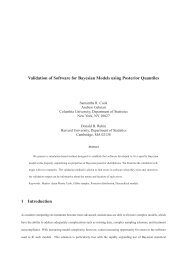Solution to selected problems.
Solution to selected problems.
Solution to selected problems.
Create successful ePaper yourself
Turn your PDF publications into a flip-book with our unique Google optimized e-Paper software.
10. X 2 is P -semimartingale and hence Q-semimartingale by Theorem 2. By Corollary of theorem<br />
15, (X − · X) Q is indistinguishable form (X − · X) P . Then by definition of quadric variation,<br />
[X, X] P = X 2 − (X − · X) P = X 2 − (X − · X) Q = [X, X] Q<br />
up <strong>to</strong> evanescent set.<br />
11. a) Λ = [−2, 1] is a closed set and B has a continuous path, by Theorem 4 in chapter 1,<br />
T (ω) = inf t : B t /∈ Λ is a s<strong>to</strong>pping time.<br />
b) M t is a uniformly integrable martingale since M t = E[B T |F t ]. Clearly M is continuous.<br />
Clearly N is a continuous martingale as well. By Theorem 23, [M, M] t = [B, B] T t = t ∧ T and<br />
[N, N] t = [−B, −B] T t = t ∧ T . Thus [M, M] = [N, N]. However P (M t > 1) = 0 ≠ P (N t > 1). M<br />
and N does not have the same law.<br />
12. Fix t ∈ R + and ω ∈ Ω. WLOG we can assume that X(ω) has a càdlàg path and ∑ s≤t |△X s(ω)| <<br />
∞. Then on [0, t], continuous part of X is bounded by continuity and jump part of X is bounded<br />
by hypothesis. So {X s } s≤t is bounded. Let K ⊂ R be K = [inf s≤t X s (ω), sup s≤t X s (ω)]. Then f,<br />
f ′ , f” is bounded on K. Since ∑ s≤t {f(X s) − f(X s− ) − f ′ (X s− )△X s } is an absolute convergent<br />
series, (see proof of I<strong>to</strong>’s formula (Theorem 32), it suffices <strong>to</strong> show that ∑ s≤t {f ′ (X s− )△X s } < ∞.<br />
By hypothesis,<br />
∑ ∣<br />
s≤t<br />
∣f ′ (X s− )△X s<br />
∣ ∣ ≤ sup<br />
x∈K<br />
|f ′ (x)| ∑ s≤t<br />
|△X s | < ∞<br />
Since this is true for all t ∈ R + and almost all ω ∈ Ω, the claim is shown.<br />
13. By definition, s<strong>to</strong>chastic integral is a continuous linear mapping J X : S ucp → D ucp . (Section<br />
4). By continuity, H n → H under ucp <strong>to</strong>pology implies H n · X → H · X under ucp <strong>to</strong>pology.<br />
14. Let  = 1 + A <strong>to</strong> simplify notations. Fix ω ∈ Ω and let Â−1 · X = Z. Then Z ∞ (ω) < ∞ by<br />
hypothesis and  · Z = X. Applying integration by parts <strong>to</strong> X and then device both sides by Â<br />
yields<br />
X t<br />
 = Z t − 1 Â<br />
∫ t<br />
0<br />
Z s dÂs<br />
Since Z ∞ < ∞ exists, for any ɛ > 0, there exists τ such that |Z t − Z ∞ | < ε for all t ≥ τ. Then for<br />
t > τ,<br />
∫<br />
1 t<br />
Z s dÂs = 1 ∫ τ<br />
Z s dÂs + 1 ∫ t<br />
 t −<br />
(Z s − Z ∞ )dÂs + Z Âτ<br />
∞<br />
 t  t  t<br />
0<br />
0<br />
τ<br />
Let’s evaluate right hand side. As t → ∞, the first term goes <strong>to</strong> 0 while the last term converges<br />
<strong>to</strong> Z ∞ by hypothesis. By construction of τ, the second term is smaller than ε(A t − A τ )/A t , which<br />
converges <strong>to</strong> ε. Since this is true for all ε > 0,<br />
1<br />
lim<br />
t→∞ Â<br />
∫ t<br />
0<br />
Z s dÂs = Z ∞<br />
Thus lim t→∞ X t /Ât = 0.<br />
14<br />
 t


